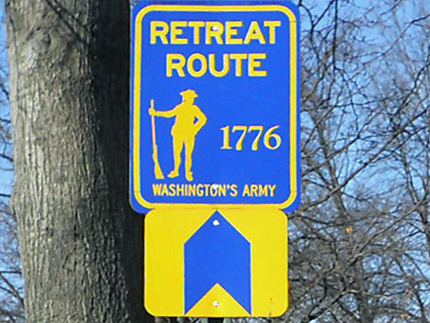





Liberty Pole
Intersection of Lafayette Ave., West Palisades Ave. and Tenafly Rd.
Map / Directions to the Liberty Pole site
Several historic signs at this corner commemorate several Revolutionary War era events that occurred in this area (known as Liberty Pole):
In 1766 a Liberty Pole was erected at this site, to commemorate the repeal of the Stamp Act. Liberty Poles were tall wooden poles, often topped with a cap. The Stamp Act imposed a tax on a wide range of paper items in the thirteen British colonies in America. The Stamp Act was very unpopular throughout the colonies. The colonists' protests against the Stamp Act was an early event on the path which led to the Revolutionary War in 1775.
The original 1766 Liberty Pole has been replaced several times. The pole at this corner today was placed here in 1964.
A tavern called the Liberty Pole Tavern existed near here, named for the Liberty Pole, and the area itself became known by this name. [1]
On November 20, 1776, the Continental (American) army retreated past here during their retreat across New Jersey, following their evacuation of Fort Lee. They were just in time to avoid a superior force of British and Hessian troops who were marching down Tenafly Road after having landed at Lower Closter Landing in Alpine. [2]
The retreat is commemorated by two signs here. A Washington's March sign has been placed on Liberty Pole. The blue Retreat Route sign is located across West Palisades Avenue from the rest of these markers; it is one of a series that runs throughout Bergen County.
August 22 - September 3, 1780, Washington's army was encamped in the Englewood / Teaneck area. During this encampment, Washington sometimes made his headquarters at Liberty Pole. Some of his letters from this time period are marked as having been sent from "Liberty Pole." [3]
Alexander Hamilton, who was serving as an aide-de-camp to General Washington, was in Liberty Pole at the time as well. On September 3, the last night of the Liberty Pole encampment, Hamilton wrote a remarkable seventeen-page letter to his friend James Duane. In this letter, Hamilton, who was only twenty-five, outlined many of the ideas behind the Constitutional Convention, seven years before the Convention occurred in 1787. Hamilton would later serve as a delegate at the Constitutional Convention and was a signer of the Constitution.[4]
On September 4, the army moved several miles, to the west of the Hackensack River, in the Paramus / Oradell, area, where they encamped until September 20.
1. ^ State of New Jersey historic sign, 1964.
2. ^ For a description of events related to the evacuation of Fort Lee, with accompanying source notes, see the Fort Lee page of this website.
For a description of landing at Lower Closter Landing, with accompanying source notes, see the Alpine page of this website.3. ^ For several of Washington's letters marked from Liberty Pole, see:
“From George Washington to Major General Benedict Arnold, 2 September 1780,” Founders Online, National Archives, https://founders.archives.gov/documents/Washington/03-28-02-0041. [Original source: The Papers of George Washington, Revolutionary War Series, vol. 28, 28 August–27 October 1780, ed. William M. Ferraro and Jeffrey L. Zvengrowski. Charlottesville: University of Virginia Press, 2020, pp. 62–63.]
“From George Washington to Jean-Baptiste Donatien de Vimeur, comte de Rochambeau, 3 September 1780,” Founders Online, National Archives (http://founders.archives.gov/documents/Washington/99-01-02-03167 [last update: 2015-03-20]). Source: this is an Early Access document from The Papers of George Washington. It is not an authoritative final version.
“George Washington to Comte de Rochambeau, 3 September 1780,” Founders Online, National Archives (http://founders.archives.gov/documents/Hamilton/01-02-02-0840 [last update: 2015-03-20]). Source: The Papers of Alexander Hamilton, vol. 2, 1779–1781, ed. Harold C. Syrett. New York: Columbia University Press, 1961, p. 420.
4. ^ For the full text of the letter, see:
“From Alexander Hamilton to James Duane, [3 September 1780],” Founders Online, National Archives (http://founders.archives.gov/documents/Hamilton/01-02-02-0838 [last update: 2015-03-20]). Source: The Papers of Alexander Hamilton, vol. 2, 1779–1781, ed. Harold C. Syrett. New York: Columbia University Press, 1961, pp. 400–418.